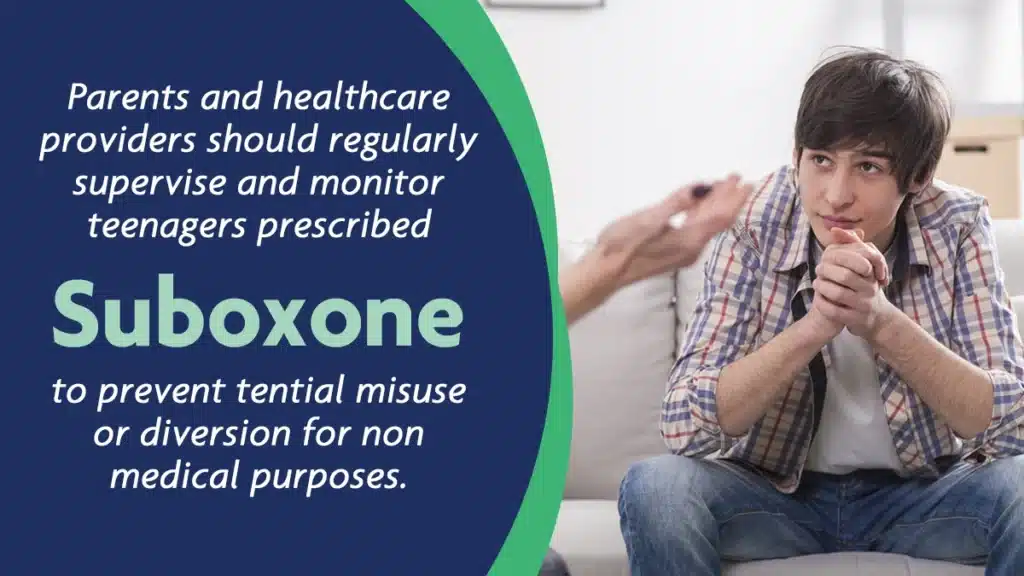In recent years, the misuse of Suboxone, a medication designed to help individuals overcome opioid addiction, has emerged as a concerning trend among teenagers.
Understanding how adolescents abuse Suboxone is crucial for educators, parents, and healthcare professionals to address this growing issue.
Key Takeaways
Suboxone is a tool for healing, not a shortcut to recreation; misusing it can pose serious risks to both physical and mental well-being. Here’s what you need to know:
- Suboxone misuse often involves self-administering higher doses than prescribed, leading to potential overdose.
- Combining Suboxone with other substances, especially central nervous system depressants like alcohol or benzodiazepines, is a common form of abuse among teenagers.
- Parents and healthcare providers should regularly supervise and monitor teenagers prescribed Suboxone to prevent potential misuse or diversion for non-medical purposes.
Contact us at (845) 479-6888 for more information on drug recovery assistance to help your child live a quality life.
What Is Suboxone Abuse?
Suboxone abuse refers to the misuse of the medication Suboxone, commonly prescribed to treat opioid addiction. Suboxone contains buprenorphine and naloxone, aiming to alleviate withdrawal symptoms and cravings.
However, individuals may misuse it by taking higher doses than prescribed, using it without a prescription, or combining it with other substances.
Abuse can lead to dependence, addiction, and adverse health effects, including respiratory depression.
Warning Signs of Suboxone Abuse
If someone is taking Suboxone, it’s important to watch signs and symptoms to encourage them to seek help from a healthcare professional.
Here are some warning signs of Suboxone abuse:
- Taking more Suboxone than prescribed
- Frequent requests for early refills
- Doctor shopping for multiple prescriptions
- Using Suboxone for a euphoric high signals
- Mixing Suboxone with other substances
- Neglecting responsibilities due to Suboxone use
- Financial issues, such as borrowing money
- Withdrawal symptoms when not using the drug
- Continued use despite consequences
Effects of Suboxone On the Body
Suboxone can be effective in treating opioid dependence, but it should only be used under the guidance of a qualified healthcare professional as part of a comprehensive addiction treatment plan.
Here are are how the components of Suboxone affect the body:
Buprenorphine: Buprenorphine, the main active ingredient in Suboxone, is a partial opioid agonist. It binds to the same receptors in the brain that are affected by opioids, but it activates these receptors to a lesser extent than full agonists like heroin or oxycodone.
This partial activation helps to alleviate withdrawal symptoms and cravings without producing the intense euphoria associated with full agonists.
Naloxone: Naloxone is included in Suboxone to deter misuse. If Suboxone is injected, naloxone can precipitate withdrawal symptoms in individuals with opioid dependence. When taken as prescribed, naloxone has minimal effect, but if the medication is crushed or dissolved and injected, naloxone can counteract the effects of opioids and induce withdrawal.
Reduction of Cravings: By binding to opioid receptors, Suboxone helps reduce cravings for opioids, making it easier for individuals to abstain from drug use.
Withdrawal Symptom Relief: Suboxone can alleviate withdrawal symptoms associated with opioid dependence. It has a longer duration of action compared to short-acting opioids, which helps in maintaining a stable and consistent state, reducing the likelihood of withdrawal.
Ceiling Effect: Buprenorphine has a ceiling effect, meaning that at a certain dose, its opioid effects plateau, and increasing the dose beyond that point does not result in increased opioid effects. This reduces the risk of respiratory depression, which is a common concern with full opioid agonists.
Safety Profile: Compared to some other opioids, buprenorphine has a lower risk of overdose, especially when taken as prescribed. This can enhance the safety of individuals undergoing opioid addiction treatment.
Maintenance of Stability: Suboxone is often used as part of a maintenance program in opioid addiction treatment. It helps stabilize patients, allowing them to focus on counseling and behavioral therapy, supporting their recovery.
Factors Leading to Suboxone Abuse Among Teenagers
Suboxone can be effective when used as prescribed in a controlled treatment setting; misuse and abuse can occur among teenagers.
Several factors may contribute to Suboxone abuse among teenagers:
Peer Pressure: Teenagers often want to fit in and be accepted by their peers. Sometimes, they might encounter friends or classmates who misuse Suboxone. The desire to belong and be part of a group can lead some teens to try Suboxone without fully understanding its purpose or risks.
Mental Health Struggles: Many teenagers face mental health disorders like anxiety, depression, or stress. Sometimes, they might think that Suboxone can help them escape from these feelings. Teens must recognize that there are healthier ways to cope, such as talking to someone they trust or seeking professional help.
Lack of Education: Sometimes, teenagers might not fully understand what Suboxone is meant for. They might think it’s a way to get high without realizing its purpose in helping people overcome opioid addiction. Increasing awareness and education about the proper use of Suboxone is essential to prevent misuse.
Accessibility: Easy access to Suboxone, whether from family members or through other means, can contribute to its misuse. Proper storage and supervision of medications at home can help prevent teenagers from experimenting with substances they shouldn’t be using.
Self-Medication: Teens might use Suboxone as a way to self-medicate without realizing the potential dangers. This can happen when they believe it will help them relax or cope with difficult emotions. Encouraging open communication about mental health and providing healthier coping mechanisms helps prevent Suboxone abuse.
Influence of Media and Pop Culture: Sometimes, the portrayal of substance use in media and pop culture can glamorize it. Teens might be influenced by what they see in movies, TV shows, or music, leading them to believe that using substances like Suboxone is an acceptable behavior.
Vulnerable Populations: Certain groups of teens might be more vulnerable to substance abuse due to various factors, such as a history of trauma, unstable home environments, or socioeconomic challenges. Understanding these vulnerabilities and providing targeted support can help prevent Suboxone misuse in these populations.
Treatments for Suboxone Addiction for Teens
Treatment for Suboxone abuse may involve a combination of medical, psychological, and behavioral interventions.
Here are some effective treatment options:
Medical Detox: The first step is often detox, which should be done under medical supervision. Abruptly stopping Suboxone can lead to withdrawal symptoms, so gradual tapering may be recommended to minimize discomfort.
Inpatient or Outpatient Rehabilitation: Depending on the severity of the abuse, a teen may enter an inpatient or outpatient rehabilitation program. Inpatient programs provide a more immersive and structured environment, while outpatient programs allow individuals to live at home but attend therapy sessions regularly for substance use disorders.
Behavioral Therapy: Various behavioral therapies, such as cognitive-behavioral therapy (CBT) and contingency management, can be effective in treating Suboxone abuse. These therapies address the underlying issues contributing to substance abuse and help individuals develop healthier coping mechanisms.
Medication-Assisted Treatment (MAT): In some cases, a healthcare provider may recommend other medications to help manage cravings and prevent relapse. This could include medications like methadone or naltrexone.
Individual and Family Counseling: Individual counseling helps address personal issues, while family counseling can involve loved ones in recovery and help improve the overall support system.
Aftercare Planning: Developing a comprehensive aftercare plan is crucial to maintaining recovery. This may involve ongoing therapy, support group attendance, and strategies to prevent relapse.
Prevention and Awareness

Preventing substance abuse, including the misuse of medications like Suboxone, and raising awareness among teenagers is crucial for their well-being.
Here are some strategies for prevention and awareness:
Prevention Strategies
- Education Programs: Comprehensive drug education programs should be integrated into school curricula to provide accurate information about Suboxone and its intended use. These programs can address the broader issue of substance abuse, highlighting the risks associated with misuse and the potential consequences.
- Communication Skills: Equipping parents, educators, and other adults with effective communication skills is essential. Encouraging open conversations about substance abuse, specifically the risks of Suboxone misuse, can foster a supportive environment for teenagers.
- Peer Support Programs: Establishing peer support programs allows older students or trained mentors to share information about substance abuse risks, including those associated with Suboxone. Peers can play a significant role in supporting and guiding their counterparts.
- Community Involvement: Engage the community in prevention efforts by collaborating with local organizations, law enforcement, and healthcare professionals. Organize events that promote a drug-free lifestyle, offering resources and support to teenagers and their families.
- Promote Healthy Coping Mechanisms: Encourage the development of healthy coping mechanisms for stress, anxiety, and other emotional challenges. By providing alternative outlets for dealing with life’s difficulties, parents can reduce the likelihood of their children turning to substances for relief.
Awareness Strategies
- Media Campaigns: Launch targeted media campaigns to raise awareness among teenagers about the proper use of Suboxone and the potential dangers of misuse. Leverage social media platforms to disseminate educational content and engage with the teenage audience.
- School Workshops: Conduct workshops led by healthcare professionals or addiction specialists in schools. These sessions should focus on educating students about the purpose of prescription medications and emphasize the risks associated with their misuse.
- Parental Involvement: Provide resources to parents to help them understand the signs of substance abuse and equip them with tools to address the issue with their teenagers. Host informational sessions for parents to dispel common misconceptions about Suboxone.
- Online Resources: Develop and promote online resources such as websites, videos, and interactive tools that offer accurate information about opioid drugs and strategies for substance abuse prevention. Utilize digital platforms to reach a wide audience effectively.
Celebrate Success Stories: Share success stories of individuals who have overcome opiate addiction with the help of Suboxone. Emphasize the importance of using the medication under proper medical supervision, showcasing positive outcomes and inspiring hope within the community.
Frequently Asked Questions
How does Suboxone affect personality?
Suboxone, a prescription medicine in the treatment of opioid dependence, may impact personality by alleviating withdrawal symptoms and cravings. It can contribute to a stabilizing effect, fostering a clearer mindset.
However, individual responses vary, and behavioral changes are often influenced by the underlying drug addiction and its treatment rather than the medication itself.
What are the most common side effects of Suboxone?
For individuals undergoing Suboxone treatment to manage opioid use disorder, common side effects may include mild euphoria, as it is a partial agonist.
Medical professionals should monitor patients for potential opioid withdrawal symptoms, nervous system effects, and any signs of drug abuse. Seeking professional medical advice from doctors is crucial for the safe management of opioid use disorders with prescription painkillers like Suboxone.
How do Subutex users abuse it?
Subutex users may abuse the medication by taking it in higher doses than prescribed, crushing or snorting the tablets to intensify effects, or injecting it for a faster onset. Some individuals may misuse Subutex to experience a euphoric sensation.
This abuse poses significant health risks, including respiratory depression and addiction. Seeking professional help is crucial for those struggling with Subutex abuse.
Help Your Teen Conquer Suboxone Addiction Now
Our dedicated teen drug rehab is committed to guiding teenagers toward a drug-free life through comprehensive addiction treatment services.
Our residential treatment program integrates holistic approaches such as art and music therapy, educational workshops, and engaging recreational activities, fostering a supportive environment for recovery.
In addition, our expert therapists empower teenagers to construct essential coping mechanisms, ensuring a resilient foundation for a brighter future.Your child isn’t alone; we’re here every step of the way. Call us at (845) 479-6888 today.


